St. John the Evangelist
Roman Catholic Church in Hopkinton, Massachusetts
20 Church Street, Hopkinton, MA, 01748
Pastor (2012-present): Very Rev. Richard E. Cannon, V.F.
Parish established in 1866
Church dedicated in 1889
The church is built of granite primarily from a quarry on Ash St. three blocks from the church.
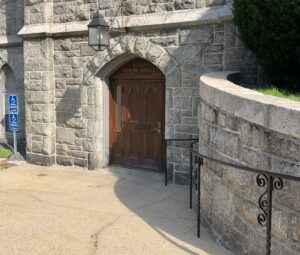
This door on the side of the church off the parking lot leads to the lower chapel, where daily Mass is said.
It leads to the office area outside the chapel, and a mail slot is right by the door.
Right inside is an elevator for accessing the upper church. The church is handicap accessible.
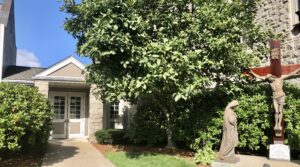
These doors lead to a handicap accessible corridor between the lower chapel and the parish center.
Enter the doors, turn left, and walk down the hallway to find the restrooms, church library, religious education offices, and parish center.
Stop by to pray before the outside, life-sized Crucifixion scene.
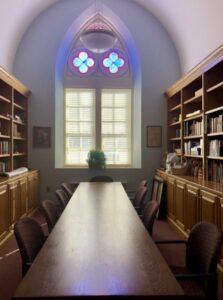
This is the church library, a place to study the faith and meditate. Some meetings are held here.
Newly donated books are regularly reviewed and added to the shelves according to subject: lives and writings of the saints, Scriptural studies, histories, Catechesis, etc…
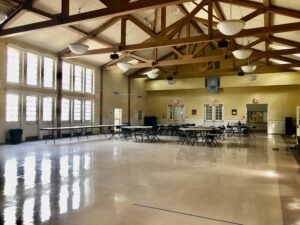
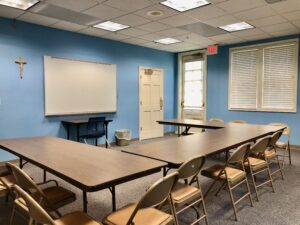
This is the parish center and one of its classrooms. There are 10 individual classrooms and a kitchen.
This is where the religious education classes take place. The hall is regularly reserved for receptions and other events, such as the Advent Wreath workshop, the Nite at the Races, and the incredible parish rummage sale.

This is the lower chapel, where daily Mass is said every morning.
A statue of our Blessed Mother is on the left of the sanctuary, and the Sacred Heart of Jesus is on the right.
Within the sanctuary are statues of St. Therese of Lisieux and St. Anne with the child Mary.
An altar rail sets apart the sacred space of the sanctuary, where our Lord is present in the Tabernacle. The red sanctuary candle indicates His presence.
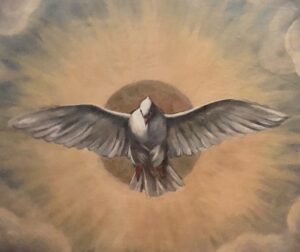
On the ceiling in the sanctuary is a round mural depicting the Holy Spirit as a dove.
A similar mural is found in the chapel of St. John’s Seminary in Boston.

Fr. John Ryan built St. John the Evangelist church in 1878. Having given his life to the building of this church, he died a few years later in 1881 at the age of 36.
Beloved by his parishioners, Fr. Ryan is buried beneath the high altar in this chapel. A brass plaque by the statue of Mary witnesses to this fact:
“Sacred to the Memory of Reverend John P. Ryan/ Born 1845 — Died 1881/ Who built this church in 1878/ His remains repose in this sanctuary/ ‘May he rest in peace’”
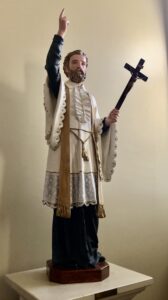
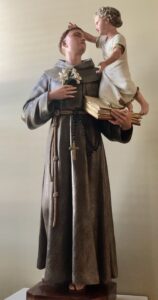
Towards the back of the lower chapel are statues of two great saints:
St. Francis Xavier, a great missionary, who proclaims the Gospel.
St. Anthony of Padua, who gazes at the Christ Child miraculously leaping from the pages of Scripture.

This is the upper church, where all weekend Masses take place, as well as most Holy Days.
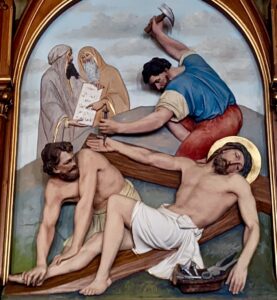
The church seats 1,200 people. Corinthian pillars, Gothic arches, vivid depictions of the Stations of the Cross, and glittering stained glass windows inspire prayer and adoration in this church built and funded largely by the Irish shoemakers of 19th century Hopkinton.
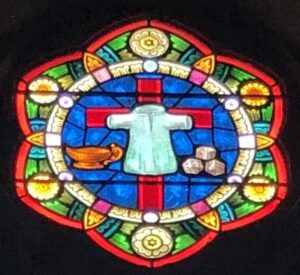
Handsome themes of greens and browns and floral patterns of stems and flowers testify to the youth and vigor of our patron saint, St. John the Evangelist, while the light blue ceiling points to the Virgin Mary, of whom St. John was the guardian. Everything in the church, the architecture, the symbols, the colors and shapes, present a coherent and transcendent whole.
Among the various symbols illuminated by the stained glass windows are the tools of the Passion, the tunic of Christ, the head of St. John the Baptist, the Holy Spirit, symbols of the Blessed Virgin Mary, and the Paschal Lamb.
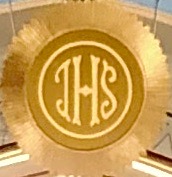
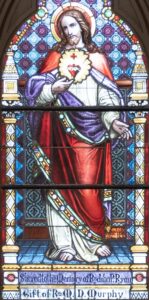
The first three Greek letters of the name of Jesus hover over the church in the gold medallion above the sanctuary.
The Sacred Heart of Jesus shines down from the sanctuary in the center stained glass window “sacred to the memory of Rev. John P. Ryan”. Facing the sanctuary, on the left of the Sacred Heart are the Blessed Virgin and St. Joseph. On the right are St. John the Evangelist (patron saint of our church) and St. Patrick (patron saint of our Boston Archdiocese).
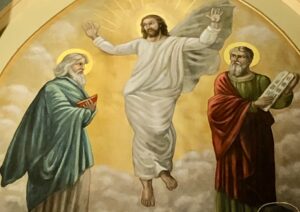
The five murals in the sanctuary, recently restored, depict the Annunciation, the Nativity, the Crucifixion, the Ascension, and Pentecost. Outside the sanctuary are murals of the Immaculate Conception and the Transfiguration.
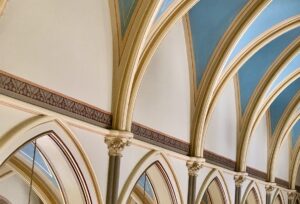
Along the sides of the nave, in the panels beneath the arches, were once an additional 14 murals, one side featuring the Seven Sacraments, and the other side featuring the Alpha and Omega, the tables of the Old Law, the Ark of the Covenant, the crib in Bethlehem, the pelican feeding her young, the Lamb, and emblems of the Passion.
The church is a sacred space, a peaceful garden, in which everything delights the eye, educates the mind, and nourishes the soul.
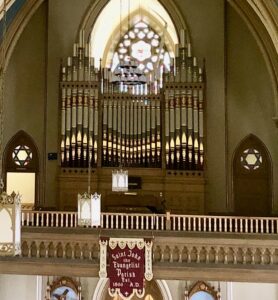
The Woodbury and Harrison pipe organ, dedicated in 1889, has 1400 pipes, thirty registers, and four combination pedals. We are blessed to have such a fine instrument accompany our liturgies every Sunday. Vatican II says of the pipe organ:
“The pipe organ is to be held in high esteem, for it is the traditional musical instrument which adds a wonderful splendor to the Church’s ceremonies and powerfully lifts up man’s mind to God and to higher things.” (Sacrosanctum Concilium)
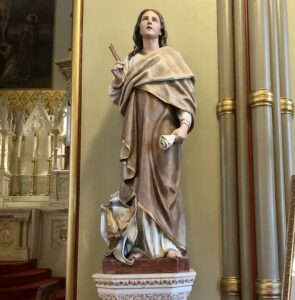

Behind the pipe organ is the eagle, symbol of St. John the Evangelist, patron of our church.

Facing the sanctuary, on the right the statue of St. John depicts the beloved disciple as a young man gazing upwards and holding a feathered pen. His symbol, the eagle, flaps its wings. The words of St. John’s Gospel soar, proclaiming the divinity of Christ.
On the left stands our Blessed Mother. Her heel strikes the head of the serpent, Satan; Her Immaculate Heart conquers evil. From the Cross, our Lord entrusted St. John with guardianship of our Lady. He named St. John the son of Mary, and with his sonship we have all become the children of our Blessed Mother:
“Woman, behold, your son!”Then he said to the disciple, “Behold, your mother!”And from that hour the disciple took her to his own home. (Jn 26-27)
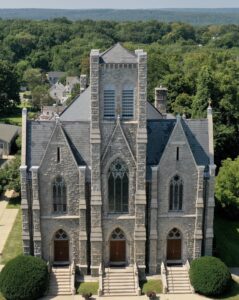
Described as a “cathedral in the woods” by Cardinal O’Connell of Boston (1907-1944), St. John the Evangelist stands firm, testifying to the endurance of the faith in a changing world.
We remember the words of Christ: “On this rock I will build my church, and the gates of Hades will not overcome it.”(Mt 16:18)
St. John the Evangelist, built of granite, is named after the apostle who remained faithful, never leaving our Lord, even in the moment of his bitter Passion and Death.
We pray that all those who worship within these granite walls may persevere in their faith until they reach the fullness of God’s glory in Heaven.
“And the Word became flesh and dwelt among us, full of grace and truth; we have beheld his glory, glory as of the only Son from the Father… And from his fulness have we all received, grace upon grace.” (Jn 1:14-16)

